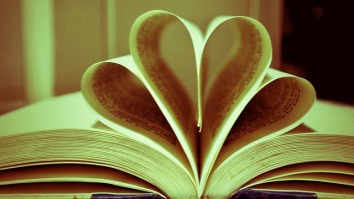
The more time you spend with the classics, the more you notice the time they spend with each other.
Because, as it turns out, the classics spend a lot of time with each other. They’re kind of obsessed with each other, consumed by each other, locking each other into their own word prisons playgrounds whenever they have the opportunity. It’s a little bit sick, and a little bit twisted, how wrapped up they are in each other’s interests and arms.
That’s why I call this phenomenon Literary Incest.
When I first took on The 100 Greatest Books Challenge way back in 2011, I created a spreadsheet to track meta-themes. My reasons ranged from the obvious (mere curiosity) to the nerd-tacular (spreadsheets are a hobby) to the profound (a need to extract meaning from this endeavor, in the form of half-assed statistics). I tracked recurring subject matter as broad as “social commentary” and “religious commentary,” plot points as specific as “protagonist dies,” “protagonist kills self,” and “protagonist attempts to kill self,” and personal impressions as vague as “characters have weird names” and “book is categorically boring.” As soon as I finished a book on The List, I would dive into my spreadsheet to tick off every box that applied.
At the far end of the spreadsheet was a column labeled Incest: references within the classics to other classics. It was here that I recorded every member of the literary “family tree”—and here that I discovered the Greek and Latin classics to be a sort of father figure to all the rest.
It’s an understatement of irresponsible proportions to say that the Greek and Latin classics show up everywhere in literature. Among the classics that make direct reference to The Iliad, The Odyssey, or The Aeneid are:
- The Divine Comedy
- Middlemarch
- The Portrait of a Lady
- The Magic Mountain
- Tristram Shandy
- Tom Jones
- In Search of Lost Time
- Gargantua & Pantagruel
And those are just the ones I happened to make note of, and that happen to appear on my List. Add to this the fact(s) that Joyce’s Ulysses parallels The Odyssey, that Lowry’s Under the Volcano parallels Ulysses, and that Virgil’s Aeneid is a kind of Odyssey/Iliad two-for-one deal, and we’ve got quite a lot of inbreeding in our hands.
Well beyond Homer and Virgil, though, we can still find countless cases of classic overlap. Middlemarch also contains allusions to Don Quixote, The Canterbury Tales, and Gulliver’s Travels. On the Road makes reference to Gargantua & Pantagruel, The Sun Also Rises, and Moby-Dick. Brave New World has a Shakespearean fixation, and Tristram Shandy is on speaking terms with Pilgrim’s Progress, Don Quixote, Hamlet, and Gargantua & Pantagruel.
Naturally, the older the book, the more often it is referred to. After the Greek and Latin epics, no book is cited more frequently than Dante’s Divine Comedy: Lolita, The Count of Monte Cristo, An American Tragedy, In Search of Lost Time, and Middlemarch borrow pieces of his genius. And some books, of course, make incest their own filthy habit. Finnegans Wake invokes nearly every preceding classic, and Lolita teases at least six others:
- A Portrait of the Artist as a Young Man
- Alice in Wonderland
- The Divine Comedy
- King Lear
- Madame Bovary
- Brideshead Revisited
…
So what are we to make of all this? If my spreadsheet is any indication, not much. Lately arrived on its deathbed, this blog is the brightest glimpse of daylight it will ever see.
But if we all put our heads together like some big, perverted family, we might come to the conclusion that the literary greats looked toward one another for inspiration. And when they found it, they gave credit where it was due. And when we’re writing, we should consider doing the same.
Or maybe it was just as show-offy then as it is now to casually name-drop Homer or Dante into conversations/publications, and they were trying to look cool.
But hey, who cares?
There are worse crimes.

That spreadsheet is a labour of love clearly. You make a good point about inter-textually showing how authors often to look to their predecessors for reference. I like to think of authors as being in a kind of dialogue with each other as they wrestle with big ideas
That’s a lovely thought. It also occurred to me that the volume of literature (and other written content) that existed 100 or 200+ years ago was only a tiny fraction of what we have now. So, presumably — at least among the wealthier, literate classes — most everyone read the same authors and books, making pop culture both narrower and more widely shared. I can’t think of many books these days that I could allude to with (near) certainty that (almost) everyone I know would “get” the reference. Harry Potter, maybe?
for me Harry Potter wouldn’t resonate that much. I mean I know some of the terms but I only read one book and saw one film. the other day there was a quiz question about the houses in Hogwarts and I didnt have the faintest idea.
I love that you made a SPREADSHEET. You’re my kind of person.
:)
If only I knew how to repurpose all the info in some attractive way… I would graphic design the shit out of my spreadsheet “data” and then share it with all the literary nerds out there. So many infographics that will never be…
The Victorians in particular just loved to show off how much they had read. Talk about name-dropping. Loved this post!
Haha so true! Let’s hope their swagger served them well. :)
Pingback: Quick Reviews (Greek Edition): #24 The Iliad, #29 The Odyssey, #49 The Aeneid | The 100 Greatest Books Challenge
Pingback: The List’s Biggest Surprises | The 100 Greatest Books Challenge
Pingback: Quick Reviews, Part VI | The 100 Greatest Books Challenge